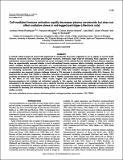Por favor, use este identificador para citar o enlazar a este item:
http://hdl.handle.net/10261/36999COMPARTIR / EXPORTAR:
 SHARE SHARE
 CORE
BASE CORE
BASE
|
|
| Visualizar otros formatos: MARC | Dublin Core | RDF | ORE | MODS | METS | DIDL | DATACITE | |

| Título: | Cell-mediated immune activation rapidly decreases plasma carotenoids but does not affect oxidative stress in red-legged partridges (Alectoris rufa) |
Autor: | Pérez-Rodríguez, Lorenzo CSIC ORCID; Mougeot, François CSIC ORCID; Alonso-Álvarez, Carlos CSIC ORCID ; Blas, Julio CSIC ORCID ; Viñuela, Javier CSIC ORCID; Bortolotti, Gary R. | Palabras clave: | Antioxidants Immune response Phytohaemagglutinin Red-legged partridge Sexual selection TAS TBARS |
Fecha de publicación: | 1-jul-2008 | Editor: | Company of Biologists | Citación: | The Journal of Experimental Biology 211, 2155-2161 | Resumen: | In animals yellow-orange-red sexual traits pigmented by carotenoids have been suggested to act as signals of current health. Because carotenoids have important physiological functions, individuals might trade-off allocating these pigments to self- maintenance versus coloration. Carotenoids may act as scavengers of free radicals that are released during an immune response. Here, we experimentally assessed whether a local cell-mediated immune response affects circulating carotenoids, antioxidant status, oxidative damage and the expression of a carotenoid-based trait. Male red-legged partridges (Alectoris rufa) were subcutaneously injected with phytohaemagglutinin (PHA) or with phosphate buffer solution (controls). The effect of the treatment on circulating carotenoids, total plasma antioxidant status (TAS), lipid oxidative damage in erythrocytes (TBARS) and ornamentation was assessed. Immune challenge induced a 13% decrease in circulating carotenoids within 24 h. However, this treatment did not affect TAS, TBARS or coloration. Coloration, circulating carotenoids and cell-mediated immune response were positively correlated, but these were not related to TAS or TBARS. Carotenoids were only weakly related to TAS after controlling for the effect of uric acid levels. These results suggest that carotenoid-based ornaments may honestly indicate immunocompetence but probably not antioxidant capacity in this species, and that carotenoids might be relatively weak antioxidants in the plasma. Furthermore, even a relatively harmless and locally elicited immune challenge had important effects on circulating carotenoids, but this effect did not appear to be associated with oxidative stress. Alternative mechanisms linking carotenoids to immunity (not necessarily relying on the use of these pigments as antioxidants) should be considered in future studies on birds | Versión del editor: | http://jeb.biologists.org/content/211/13/2155.full.pdf+html | URI: | http://hdl.handle.net/10261/36999 | DOI: | 10.1242/jeb.017178 |
| Aparece en las colecciones: | (EBD) Artículos |
Ficheros en este ítem:
| Fichero | Descripción | Tamaño | Formato | |
|---|---|---|---|---|
| 2008_Perez-Rodriguez et al 2008 JExpBiol 211 2155-2161.pdf | 166,48 kB | Adobe PDF |  Visualizar/Abrir |
CORE Recommender
SCOPUSTM
Citations
81
checked on 18-abr-2024
WEB OF SCIENCETM
Citations
75
checked on 23-feb-2024
Page view(s)
359
checked on 23-abr-2024
Download(s)
219
checked on 23-abr-2024
Google ScholarTM
Check
Altmetric
Altmetric
NOTA: Los ítems de Digital.CSIC están protegidos por copyright, con todos los derechos reservados, a menos que se indique lo contrario.
